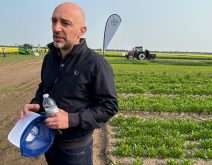Researchers from the United States Department of Agriculture and University of Vermont have produced a clone of a purebred Jersey cow whose cells may offer a biotechnological defense against mastitis disease.
Geneticist Kevin Wells of USDA said it will be at least another year before the cow, named Annie and born last March, begins producing milk. Only then can scientists begin testing for mastitis resistance.
Though not the first cow clone, Annie is the first to be genetically altered with a gene for an agricultural application.
Read Also

VIDEO: The Western Producer Markets Desk crop outlook for 2025
Watch this video for a 10-minute update of Prairie crop conditions and markets. Bruce Burnett, a weather and market analyst…
Mastitis costs U.S. dairy farmers about $1.7 billion (US) annually, including lost milk revenues, Wells said.
About 30 percent of all mastitis cases in dairy cows are caused by Staphylococcus aureus bacteria that destroy milk-secreting cells in the animal’s mammary gland.
Antibiotics are only effective in 15 percent of cows infected with S. aureus, so dairy producers are forced to cull those cows from their herds.
Scientists hope that Annie will resist cellular attacks by secreting an added protein called lysostaphin.
“We’re also trying to identify naturally occurring resistance genes, though very few of them have been found,” said research leader Vernon Pursel.
Whether bioengineered or naturally occurring, he said, “resistance would lessen mastitis’s financial drain, and provide the added public health benefit of reduced antibiotic usage.”
In 1999 trials with seven transgenic strains of lysostaphin-producing mice, the protein effectively killed S. aureus bacteria in both the genetically modified rodents’ mammary glands and in milk, physiologist Robert Wall said.
He and David Kerr of UV’s animal sciences department, who is a graduate from the University of Saskat-chewan, report the results in the January 2001 issue of the journal Nature Biotechnology.
S. aureus was targeted by scientists because it is among the most virulent of mastitis-causing pathogens, and causes about 30 percent of all infections in cows.
The gene for lysostaphin comes from a benign species of Staph – S. simulans – that competes with its virulent cousins.
Large-scale laboratory testing of lysostaphin mice will help researchers learn whether results observed in these transgenic rodents will apply to Annie and her offspring.
However, Pursel said practical application of the cloning technology is several years off.
First, a number of questions must be thoroughly researched:
- How much lysostaphin will be secreted by a transgenic cow’s mammary tissues, and will that amount keep Staph at bay?
- How likely are the bacteria to develop lysostaphin resistance?
- Once secreted into milk, what’s the protein’s biochemical fate?
- Is it allergenic, and will it interfere with cheese production or other processes?
Another objective is to refine the scientists’ cloning procedure, called somatic cell nuclear transfer.
Annie’s start began with a type of somatic cell called a fibroblast.
Using a mild electrical current, scientists inserted genes for lysostaphin, a green fluorescent protein tag and an antibiotic marker into the fibroblast’s nucleus. They also inserted a sheep gene for beta lactoglobulin, a “switch” that instructs mammary cells to make lysostaphin.
Later, scientists fused the altered fibroblast to an unfertilized cow egg, whose nuclear DNA contents had been removed so the fibroblast’s could move in.
About 60 percent of fused cells survive, and start dividing like a normal fertilized embryo, Pursel said.
The healthiest embryos – which included Annie – were cultured and implanted into surrogate mothers.
So far, Annie is the first calf brought to term.
Genetic testing of umbilical cord tissue at birth confirmed that she is indeed transgenic.
















